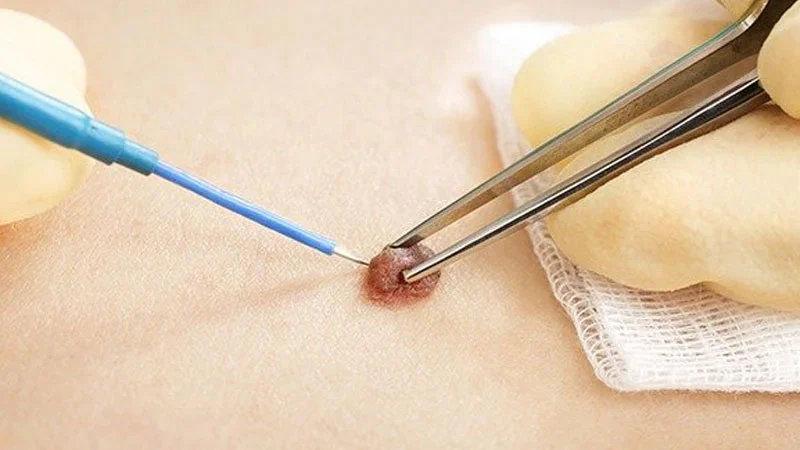Genital warts are warts caused by the HPV virus and can appear on many parts of the body. Their treatment is both surgical and medical.
The method we recommend and prefer for the treatment of superficial, i.e., non-raised moles, is the laser method, which allows the conversion of electrical energy into heat energy. Through this device, the process of removing superficial moles has a high success rate, and no scars are left.

Radiofrequency Mole Treatment (Evaporating Moles)
Radiofrequency, which is used in the treatment of many health problems, also proves its success in nevus treatment. In this method, where electrical energy is converted into radio waves, superficial and raised moles are vaporized and eliminated. This process, which can be completed in as short as 3 minutes, does not require any cutting, stitching, or dressing, thus offering significant advantages.
Before and After Non-surgical Mole Treatment
Apart from these scientific methods, various methods can be learned from the internet or surroundings for the removal of moles. For example, there are herbal cures that can be applied at home for mole treatment. At the same time, many people try to remove their moles by tying them with a thread. These methods are absolutely outdated and can also pose risks. Therefore, they should not be tried, and moles should not be tampered with.
Does Removing Moles Leave Scars?
The answer to this question is directly proportional to the method applied. Saying yes or no directly would be an incorrect response. For example, moles removed by surgery may leave a stitch mark, which can be more disturbing than the mole itself.
However, moles removed by methods such as laser or radiofrequency do not leave any scars or may leave a mark much less noticeable than an acne scar. This barely noticeable mark would not be discernible from a conversational distance.
Moles, medically known as nevi, are benign skin problems that can appear in everyone, from babies to adults, either congenitally or during puberty. They can be circular or oval and form anywhere on the body.
Moles on the lips or chins of some people can add a unique characteristic to the person. However, they can be in an uncomfortable position in others. Having up to 40 skin tags on the human body can be considered normal.
How Are Moles Treated?
There is no scientific information about why moles form to this day. Although there is a possibility that they can lead to skin cancer, the number of people who have died from cancer caused by moles today is quite low.
In this sense, existing moles can be removed early, before it’s too late, without posing any risk or causing a life-threatening situation.
Why Do Moles Form?
Although the exact cause of moles is unknown, experts have common theories. The substance called melanin, which gives color to the skin, is produced by melanocyte cells.
Under normal conditions, this substance spreads evenly across the human body, giving it color. However, for unknown reasons, when this substance clusters in a single point, it causes the formation of a nevus or mole. The density of this group determines whether the case will be large or dark in color. As mentioned earlier, moles, including those on the scalp and genital area, can appear anywhere on the body.
Should Moles Be Removed?
Moles do not pose any risk when they remain constant in color and size. However, if there is sliding, color change, or growth in their location, a doctor should be consulted immediately. Some moles may also shrink and disappear over time, although this is less common.
Many moles can significantly bother individuals due to their location. For example, moles located where the belt of pants might press can cause substantial problems. Removing such bothersome moles would be a wise decision. Additionally, moles that cause an unsightly appearance for aesthetic reasons can also be removed.
What Are the Types of Moles?
There can be colorless, dark, raised, superficial, large, small, hairy, and hairless moles on the human body.
Which Doctor/Department Should Be Consulted for Mole Removal (Treatment)?
There are different branches and specialists to visit for various diseases or minor problems. When it comes to nevi or moles, there are two branches you can visit: a plastic surgery specialist and a general surgery specialist. Specialists in these branches can perform mole treatment. However, it’s important to know how and by which method the treatment is conducted.
Some doctors may perform the treatment with surgical methods due to the technological limitations of the institution they work in. However, mole treatment can be completed in an average of 3-5 minutes without surgery, without any cuts, stitches, dressings, or similar disadvantages. In this sense, plastic surgery and general surgery specialists who provide treatment with non-surgical methods can be preferred.